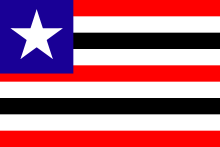Joaquim de Sousa Andrade
Joaquim de Sousa Andrade, better known by his pseudonym Sousândrade[1] (July 9, 1833 – April 20, 1902), was a Brazilian poet, adept of the "Condorist" movement. His poetry, exceedingly innovative for the time it was published, is now considered an early example of Symbolism and Modernism in Brazil.
Joaquim de Sousa Andrade | |
|---|---|
 A photograph depicting Andrade | |
| Born | July 9, 1833 Guimarães, Maranhão, Brazil |
| Died | April 20, 1902 (aged 68) São Luís, Maranhão, Brazil |
| Pen name | Sousândrade |
| Occupation | Poet |
| Alma mater | Sorbonne |
| Literary movement | Romanticism |
| Notable works | Harpas Selvagens, Guesa |
He also designed the flag of the Brazilian State of Maranhão.
Biography
Sousândrade was born in the city of Guimarães, in the Brazilian State of Maranhão, in 1833. He published his first poetry book, Harpas Selvagens (Wild Harps), in 1857. He travelled to many countries, such as France (where he graduated in Linguistics and mining engineering at Sorbonne) and the United States, where he settled in 1871. It was while in the U.S.A. that he wrote Guesa, an epic poem based on a Quechua legend about a teenager Indian who is going to be sacrificed to the Sun God. Guesa is characterized by the employment of neologisms and vertiginous metaphors; thus, it is considered by some critics a precursor work of Modernism, however this was only acknowledged decades after his death. From 1871 to 1879 he was secretary and collaborator for the periodical O Novo Mundo, directed by José Carlos Rodrigues in New York City.
Returning to Maranhão, in order to commemorate the proclamation of the republic in Brazil, he became president of the mayor's office of São Luís in 1890. He founded many schools, realized reforms in the education and idealized the flag of Maranhão. He also planned to be a senator in 1890, but quit before the elections were held.

Sousândrade died poor, forgotten and allegedly mentally ill in São Luís, in 1902. His works, forgotten for decades, were only rediscovered in the 1960s and the 1970s, thanks to the efforts of Augusto and Haroldo de Campos. Ironically, he has said once of his poem Guesa, in 1877:
People said to me more than once that my Guesa Errante will be read only 50 years later [after its publication]. I got sad — a deception of who wrote it 50 years before.
Works
See also
References
- "Sousândrade". Enciclopédia Itaú Cultural de Arte e Cultura Brasileiras. Retrieved 20 September 2016.
External links
- Excerpts of poems by Sousândrade (in Portuguese)